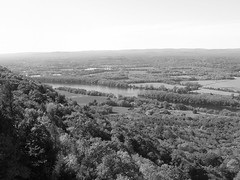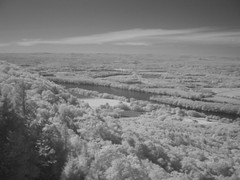Different types of light are important in astronomy, as they are tracers for different processes and temperatures inside the objects we're looking at. Since we can never go to most of the objects we study, it's crucial that we get as much information as we can from light alone. For example, IR light is good for studying cold objects, and for studying objects that are hidden inside a cloud of dust.
Take a look at the three photos below. They are (in order) normal visible light as our eyes see it, a black and white version of what our eyes normally see (visible light), and an infrared image (displayed in black and white). (Click on the images for bigger versions.)



Notice how in the last image, the water and the sky appear darker. This means that they are not sending as much IR light towards the camera as they are sending visible light. Specifically, this is the same reason as the sky is blue: light from the Sun comes in all colors. Red light (and infrared light) tends to go straight through the Earth's atmosphere. Blue light, however, gets scattered by dust in the air, so as a result the whole sky looks blue. Since the red light goes straight through, this is also why at sunset the Sun looks red. Since the IR light goes straight through as well, when we look at the sky in IR light, we do not see the IR light from the Sun scattered throughout the sky, so the sky looks dark. Lakes look bright blue because the blue light of the sky is then reflected back at our eyes, so in IR lakes and rivers would also appear dark. Note however, that the clouds on the horizon of the IR image do appear bright - the high water content in these clouds does scatter the IR light back towards the camera.
Similarly, IR light goes right through thin clouds in space (just like it goes through our atmosphere), but it does eventually get stopped by thicker clouds (just like the clouds on the horizon in the last image). Because of this, we have to use radio waves to see through the densest clouds. And also because of the clouds and moisture on Earth, we cannot actually do sensitive IR imagery from the ground, and have to instead do it from very high mountaintop observatories (above much of the Earth's atmosphere), or from space telescopes like Spitzer.

No comments:
Post a Comment